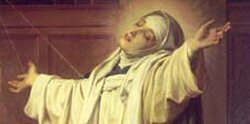New York Times
Published: March 9, 2008
Published: March 9, 2008
BROTHER GARY CREGAN, a Franciscan friar and the principal of St. Anthony’s High School here, speaks plainly when discussing the modernist architecture of many area parochial schools and churches built in the mid-20th century.
“I have a general disgust for Catholic architecture since the 1950s,” he said recently. Dressed in a brown (BLACK) habit belted with rope, he becomes animated — even enthusiastic — as he discusses the high school’s plan to build a new, more traditional chapel.
The $3 million structure, designed by Baldassano Architecture, is inspired by a 12th-century Romanesque apse (the Fuentiduena Chapel) that is part of the Cloisters collection of the Metropolitan Museum of Art in Upper Manhattan, according to Alex Badalamenti, one of the architects who worked on the school’s design.
That ancient apse, from Segovia, Spain, is a semicircular room with a half-dome ceiling and a central fresco.
The new school chapel, with a yellowish limestone veneer that does faintly resemble the coloring and style of the Cloisters apse, also adds a bell tower, and is meant to bring back an older tradition of worship, Brother Cregan said.
Many modernist churches, he added, are laid out horizontally. The school chapel that is being replaced, for example, is integrated into a side wing of the building with a classroom-style entry door, across the hall from a science lab. Its ceilings are eight feet high, and behind the pews there is a small niche with an electronic keyboard.
By contrast, the new building and its tower are rising from behind a glass corridor that connects the two wings of the school — classrooms on one side and the gym and auditorium on the other.
Brother Cregan and other Franciscans who “want to stress verticality,” he said, believe that the new chapel, with its soaring 30-foot ceilings, will teach teenagers that they are “worshiping God, not each other.” (AMEN!)
In church architecture, the return to traditionalism is a trend across the country, according to Duncan Stroik, a specialist in the design of Catholic churches.
Mr. Stroik is also a professor at the University of Notre Dame, in the school’s classical architecture and traditional cities program, one of the few of its kind.
For a high school, he said, the decision to go traditional is unusual. “It’s so interesting that the high school is fairly contemporary, but the chapel is consciously a separate building,” he said. “Even from the outside, you can tell that it’s something different.”
Mr. Stroik explained that many of his clients these days express the desire for a church that lures people, rather than one that simply provides a functional gathering place.
As he put it: “There’s this sense that in walking into a vertical space, whether it’s St. Patrick’s Cathedral or Grand Central station, on the one hand you are in awe of how grand it is, and how small you are. But also there’s a kind of feeling that you are lifted up, you are ennobled.”
In the case of the Huntington school’s new chapel, some ennobling accessories were acquired with the help of modern technology. Stepping gingerly through the chapel construction site, Mr. Cregan pointed out his bargain-price purchases on eBay, the Internet auction Web site. These included the confessionals and pews, a 110-year-old arched stained glass window and a 100-year-old statue of St. Anthony. (There is also a 14th century marble altar front with a traditional pelican design - you can see the altar front and more pictures of the chapel HERE)
He is proudest of the bell suspended from the top of the tower — another eBay find, for $4,000. A new one would have cost $20,000, according to John Petrocelli of the J. Petrocelli Construction Company, which is building the chapel.
The new chapel will seat 300, about twice the number accommodated by the current chapel. But for Brother Cregan and the school administration, bringing the chapel more in line with purist Franciscan traditions is the more pressing goal.
Many details of the design, including the unadorned archways and a wooden trussed ceiling in place of the more grandiose arched ceiling of stone or brick, have a Franciscan air, Mr. Stroik said. “There seems to be a Franciscan simplicity about it,” he added. “Looking at the exterior, there’s a simple stone facade, simple openings. The tower — it’s traditional, but not very ornate.”
There are 11 Catholic high schools on Long Island, according to the Diocese of Rockville Centre. Enrollment has been rising steadily by about 2 percent in the high schools over the last decade, Brother Cregan said, after a period in the late 1980s when several parochial schools in the area closed. St. Anthony’s is coeducational, with 2,400 students in Grades 9 through 12. Some students commute from as far east as Cutchogue and Water Mill, or from Queens to the west.
The school, which moved to its current campus in 1984 from Kings Park in Smithtown, is making other changes too. A field behind the school now holds a steel skeleton that will eventually be a $34 million 140,000-square-foot student activities center. The rendering, on a sign near the site, shows a glassy modern design.
Next fall, when the chapel is complete, students will take up the ancient activity of bell ringing for services, using a simple rope in the bell tower.
There might be some laughing from kids watching through the glass wall in the cafeteria next door. But that’s the idea, Brother Cregan said. “It’s in classic Franciscan fashion,” he explained, for the church to be “in the marketplace, not high on a hill.”
“I have a general disgust for Catholic architecture since the 1950s,” he said recently. Dressed in a brown (BLACK) habit belted with rope, he becomes animated — even enthusiastic — as he discusses the high school’s plan to build a new, more traditional chapel.
The $3 million structure, designed by Baldassano Architecture, is inspired by a 12th-century Romanesque apse (the Fuentiduena Chapel) that is part of the Cloisters collection of the Metropolitan Museum of Art in Upper Manhattan, according to Alex Badalamenti, one of the architects who worked on the school’s design.
That ancient apse, from Segovia, Spain, is a semicircular room with a half-dome ceiling and a central fresco.
The new school chapel, with a yellowish limestone veneer that does faintly resemble the coloring and style of the Cloisters apse, also adds a bell tower, and is meant to bring back an older tradition of worship, Brother Cregan said.
Many modernist churches, he added, are laid out horizontally. The school chapel that is being replaced, for example, is integrated into a side wing of the building with a classroom-style entry door, across the hall from a science lab. Its ceilings are eight feet high, and behind the pews there is a small niche with an electronic keyboard.
By contrast, the new building and its tower are rising from behind a glass corridor that connects the two wings of the school — classrooms on one side and the gym and auditorium on the other.
Brother Cregan and other Franciscans who “want to stress verticality,” he said, believe that the new chapel, with its soaring 30-foot ceilings, will teach teenagers that they are “worshiping God, not each other.” (AMEN!)
In church architecture, the return to traditionalism is a trend across the country, according to Duncan Stroik, a specialist in the design of Catholic churches.
Mr. Stroik is also a professor at the University of Notre Dame, in the school’s classical architecture and traditional cities program, one of the few of its kind.
For a high school, he said, the decision to go traditional is unusual. “It’s so interesting that the high school is fairly contemporary, but the chapel is consciously a separate building,” he said. “Even from the outside, you can tell that it’s something different.”
Mr. Stroik explained that many of his clients these days express the desire for a church that lures people, rather than one that simply provides a functional gathering place.
As he put it: “There’s this sense that in walking into a vertical space, whether it’s St. Patrick’s Cathedral or Grand Central station, on the one hand you are in awe of how grand it is, and how small you are. But also there’s a kind of feeling that you are lifted up, you are ennobled.”
In the case of the Huntington school’s new chapel, some ennobling accessories were acquired with the help of modern technology. Stepping gingerly through the chapel construction site, Mr. Cregan pointed out his bargain-price purchases on eBay, the Internet auction Web site. These included the confessionals and pews, a 110-year-old arched stained glass window and a 100-year-old statue of St. Anthony. (There is also a 14th century marble altar front with a traditional pelican design - you can see the altar front and more pictures of the chapel HERE)
He is proudest of the bell suspended from the top of the tower — another eBay find, for $4,000. A new one would have cost $20,000, according to John Petrocelli of the J. Petrocelli Construction Company, which is building the chapel.
The new chapel will seat 300, about twice the number accommodated by the current chapel. But for Brother Cregan and the school administration, bringing the chapel more in line with purist Franciscan traditions is the more pressing goal.
Many details of the design, including the unadorned archways and a wooden trussed ceiling in place of the more grandiose arched ceiling of stone or brick, have a Franciscan air, Mr. Stroik said. “There seems to be a Franciscan simplicity about it,” he added. “Looking at the exterior, there’s a simple stone facade, simple openings. The tower — it’s traditional, but not very ornate.”
There are 11 Catholic high schools on Long Island, according to the Diocese of Rockville Centre. Enrollment has been rising steadily by about 2 percent in the high schools over the last decade, Brother Cregan said, after a period in the late 1980s when several parochial schools in the area closed. St. Anthony’s is coeducational, with 2,400 students in Grades 9 through 12. Some students commute from as far east as Cutchogue and Water Mill, or from Queens to the west.
The school, which moved to its current campus in 1984 from Kings Park in Smithtown, is making other changes too. A field behind the school now holds a steel skeleton that will eventually be a $34 million 140,000-square-foot student activities center. The rendering, on a sign near the site, shows a glassy modern design.
Next fall, when the chapel is complete, students will take up the ancient activity of bell ringing for services, using a simple rope in the bell tower.
There might be some laughing from kids watching through the glass wall in the cafeteria next door. But that’s the idea, Brother Cregan said. “It’s in classic Franciscan fashion,” he explained, for the church to be “in the marketplace, not high on a hill.”
























